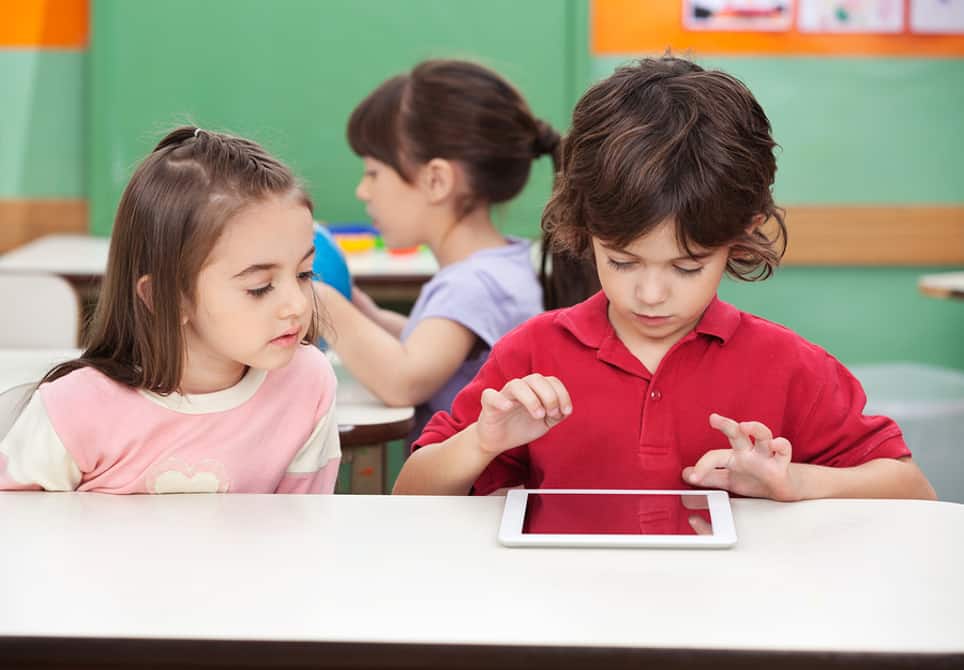Transforming Teaching and Learning at an Early Age: EPISD Early Childhood Integration Model

By Tim Holt
The El Paso Independent School District (EPISD) in El Paso Texas is a district that is in the midst of a system-wide cultural change. One of those systemic changes is the shift away from traditional teaching and learning strategies towards a more personalized, active learning model. Another shift is away from paper pencil assignments towards more digitally infused activities that engage students and teachers as well. The district is also on a path towards a districtwide dual language approach where students learn their content in equal parts English and Spanish.
Early Dual Language Learners
Nowhere is that more evident than in EPISD’s Early Childhood Technology Integration Program. This program, the brainchild of the District’s Director of Connecting Languages Mariana Balsiger, combines technology in the district’s early childhood classes (Pre-kinder to Second grade) across the district that promotes learning in two languages through the use of content creation programs.
“We do not want our students using technology as just a substitute for paper-pencil exercises,” stated Balsiger. “We want our students creating, connecting and using technology in ways that simply cannot be done with older pedagogical techniques. We want to transform learning and we can do this through a combination of technology and pedagogical shifts.”
Working with the district’s early childhood teachers and the District’s Instructional Technology Specialists, Balsiger and her team researched how to use technology (iPads) to move beyond simple “click and get” programs. The teachers were tasked with finding programs (apps) that would engage the students, and would be used to create a program that integrated a combination of technology as well as a blend of traditional small group teaching.
The stated goal of the teacher’s work is to increase the use of oral language and content appropriate vocabulary in both English and Spanish at the district’s Title 1 Campuses.
Active and Blended Learning Engagement
The result is the EPISD Early Childhood Integration program, where teachers use active learning strategies with their students, blended learning (such as the station rotation model) in all classes and an emphasis on writing in all of the core (Science, Math, Social Studies and English Language Arts) content areas.
The program supplies each teacher’s class with a set of eight iPads, which can be used in station models or in small group settings. The preloaded apps that have been vetted by program teachers to achieve the stated goals above. These apps are heavy on content creation, not on simply looking at the screen and clicking on a picture. For instance, students might use a program such as Sock Puppets to create a small conversation between two characters that explains a concept that they learned in class. The “puppets” might have a bilingual conversation, with one of the them speaking in English and another in Spanish. In any case, the technology makes the lesson outcome more engaging, more memorable and more fun.
All teachers in the program received ongoing professional development that includes work on the Pentadura SAMR model of technology integration. The hope is that teachers use the SAMR model to reflect deeply on how lessons are truly integrating technology into the learning cycle. Of course, professional development also includes the proper use of the provided technology. Many teachers will gravitate towards low hanging fruit when it comes to having students integrate technology, but the El Paso program emphasizes the state of Texas’ Technology Application standards that are based largely on the ISTE NETS for students.
Is This Model Working?
Is the El Paso model a success? Early indicators are that it is. The combination of Active Learning Strategies, Blended Learning models, Technology Integration and dual language learning seems to be potent. Teachers report students being more engaged, usage of the technology is higher than in similar campuses without the program and teachers report a certain level of excitement themselves from the change.
There is little argument that the dual language approach to teaching and learning creates students that will be more successful not only in later in their academic career but in their post academic life. The El Paso model seems to be, at least in its early stages, a model for early childhood academic success.
 This blog is part of the Supporting English Language Learners Series with support from The Bill & Melinda Gates Foundation. For more, stay tuned for the culminating podcast, infographic and publication.
This blog is part of the Supporting English Language Learners Series with support from The Bill & Melinda Gates Foundation. For more, stay tuned for the culminating podcast, infographic and publication.
For more see:
- Why PD for ELL Educators Matters
- 5 Best Practices for Supporting Refugee ELL Students
- Next-Gen Personalized Learning for ELL Students
Tim Holt is the Director of Instructional Technology for the El Paso Independent School District. Follow him on Twitter: @timholt2007 and on Holtthink.
Stay in-the-know with all things EdTech and innovations in learning by signing up to receive the weekly Smart Update. This post includes mentions of a Getting Smart partner. For a full list of partners, affiliate organizations and all other disclosures please see our Partner page.





0 Comments
Leave a Comment
Your email address will not be published. All fields are required.